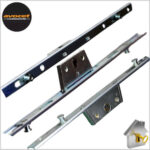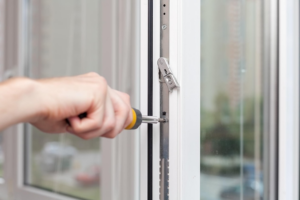You'll Never Guess This Upvc Door Locking Mechanism Replacement's Tric…
페이지 정보
작성자 Marietta 작성일 24-12-23 13:19 조회 6 댓글 0본문
 Upvc Door Locking Mechanism Replacement - DIY Or Call in a Professional?
Upvc Door Locking Mechanism Replacement - DIY Or Call in a Professional? The door lock is a vital element of security for your home. It can be difficult to enter your home if the lock is damaged or is no longer working.
The door lock is a vital element of security for your home. It can be difficult to enter your home if the lock is damaged or is no longer working.It is easy to replace door lock the multipoint locking mechanism of a upvc door. However, you should always make sure that you buy an alternative lock from the same manufacturer to ensure it will fit.
Repairing a stuck locking cylinder
A functional door lock will help you keep your home and its contents safe. It can be a hassle and even dangerous when it fails to work. However, there are easy steps you can take to resolve the issue. Lubricant can be used to free the cylinder from. This will allow you to open and close your uPVC doors without worrying about the security of your home.
The first step is to determine the uPVC door lock you are using. It will have markings that show the brand name or serial number. You can also take off the handle to inspect the cylinder. Once you have identified the kind of cylinder it is, you can replace door lock the cylinder.
A common problem is a broken gearbox that makes it impossible to push down the handle. This can be caused by damage or ageing. A professional locksmith will be able to fix this problem for you.
Also, you should check your uPVC doors and windows for signs of wear. This will ensure that you have an entrance that is secure and functional and help you spot problems before they worsen. This will prevent you from having to spend money on costly repairs in the near future.
It's a good idea to study the instructions from the manufacturer and then gather the necessary tools before you begin any repairs. This will help you to know how the system works and make the repair process easier. You may need a screwdriver, hammer, wrench and drill. It's also important to wear work gloves to protect yourself from injury caused by sharp edges.
Before finishing, you should also test the cylinder. This can be done by inserting a lock and turning it. Make sure that the tongue fits in the cylinder properly and that the key is compatible with the door you want to. You can utilize a spirit level to check the alignment of the cylinder with respect to the hinges.
Changing your uPVC lock mechanism can be intimidating initially but it's actually an easy job and you can do it yourself without the necessity of a locksmith. It is important to examine the cylinder and handle after you've replaced your uPVC locks.
Adjusting the keep
This is a relatively simple job that can be accomplished by anyone who has some basic DIY handyman skills. If you are not a seasoned locksmith, it's best to have a professional take on the job. This will help you to get the results that you want, and avoid unnecessary damage to your frame or door.
Before beginning the repair process, it's important to consult your manufacturer's instructions for any specific instructions regarding the repair of your uPVC lock. Get the tools and other materials you'll require to complete the project. Additionally, make sure that you're safe to work by placing a doorstop or block of wood under your door to ensure it is steady while you work.
Depending on the cause of the issue You may have to remove a portion of your door's hardware in order to inspect the mechanism. In this case it is crucial to use an approved lubricant from the manufacturer. This lubricant shouldn't attract dirt or dust. It is recommended that you lubricate the hinges on your internal door every six months or earlier in the event that you notice they are becoming stiff.
There are several reasons why your uPVC door could be stuck. It could be that the door is misaligned. This is a common problem in older doors. Changes in weather can also cause the replacing door locks to expand or contraction. This can cause the lock to get stuck.
It could be that the gearbox is not functioning properly when the handle doesn't lift the latch to secure the doors. This is a relatively simple fix for the majority of homes. This isn't a solution for doors that have been hit or kicked, since the uPVC handles are not likely to be able to withstand such a force.
A good way to check whether the issue is with the gearbox is by opening the door using a key, and then observe how high the handle rises in relation to the hinge. If the gap appears to be excessively large, then it's an indication that the gearbox has broken or worn out.
replace upvc door lock the lever or handle
It might be difficult to change your upvc lock at first but it's not as difficult as you think. Utilizing simple tools and the right information will allow you to get the job done in no time. You may be able to save a lot by doing it yourself, instead of hiring a locksmith to do the task. The most important question is: Do it yourself or employ a professional? The challenge you face on your own is a great way to save cash and learn new techniques however, if it develops into Thor's hammer-switch meeting Ragnarok then it's better to hand the job to an expert.
If the handle of your patio door lock replacement is sloppy or loose after inserting the key this is typically a sign that the internal mechanisms have started to fail. Most often, this is because the gearbox is wearing down. It is costly, but a professional locksmith will repair the gearbox so that your upvc is working properly.
The most frequent issue with upvc door handles is that they can't be raised to lock the door once it is closed. This can be due to the cylinder lock or the handle, or by the locking mechanism itself. The key is usually required to be inserted into the keyhole at a slight angle and then turned to unlock the door. However, this may be difficult to accomplish when the handle is too loose or sloppy.
This can be an indication of a worn-out or damaged cylinder or a damaged rod. The easiest solution is to lubricate the barrel of the lock, ensuring that it's in a proper alignment with the handle. You can use lubricants such graphite and WD-40, or a specialist lubricant designed for multipoint mechanisms. Regularly lubricating will prevent your upvc locks from getting stiff and will keep them working correctly for longer. It is recommended to do this every six months to ensure smooth operation. Use a lubricant containing PTF to prevent dirt and grime from clogging up the mechanism. This will allow you to rotate and lock the handle.
Fixing a mechanism for sticking
The door mechanisms of uPVC locks require regular maintenance to ensure they function smoothly and reliably. If they are not maintained properly, they can become stiff or even jammed. This can lead to the loss of security. However, there are methods to correct these issues before they turn into major repairs or a total breakdown of the system. The key to success is to determine the root cause and then address it immediately.
Dirt or debris is among the most common causes of a stiff locking mechanism. This could cause the handle or latch to get stuck in its housing. This is a relatively easy issue to identify. Just place a flathead screwdriver beneath any hinge cap that is sticking out of the door's side and pop them off to reveal the ends of the hinge pins. Tap each pin with a hammer to lift them out of the barrels of the hinges. The door handle that is damaged, or locking mechanism, will now be free to move.
A misalignment of the frame and door can also cause stuck uPVC. This could be caused by a change in the weather, resulting in contraction or expansion of the door. To prevent this from happening, it's a good idea to apply a light lubricant to the inside of your door lock every six months or at least, use an approved graphite-based product which doesn't attract dust as much as petroleum-based lubricants.
If you're unable to solve the issue with a new handle or lever or by adjusting the current one, it might be necessary for the entire mechanism of locking to be replaced. This is a relatively easy task that homeowners are able to accomplish. Before starting, it's a good idea to refer to the manual for your particular lock manufacturer for specific instructions on your particular lock, and to gather all of the required tools and spare parts prior to starting. It's also important to place an obstruction like a doorstop or block of wood beneath the door to ensure it stays steady as you work.
Before you remove the old lock, be sure you recognize the manufacturer by examining the name or marking on the handle's faceplate. This will make it easier to find a lock that matches the style of the original.
- 이전글 20 Trailblazers Setting The Standard In Private Adhd Assessment
- 다음글 See What American Fridge Freezer 80cm Wide Tricks The Celebs Are Utilizing
댓글목록 0
등록된 댓글이 없습니다.






